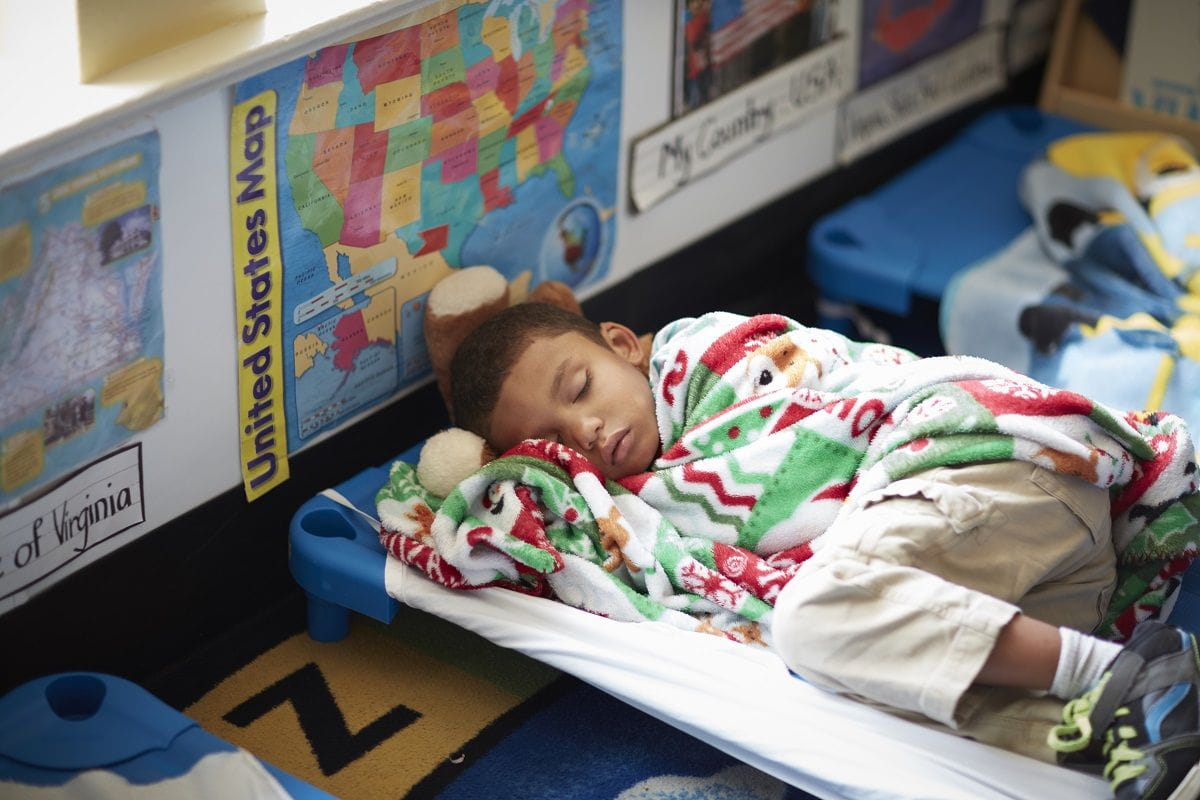How to Help Baby Nap Longer Than 30 Minutes

Even if your child is typically a super snoozer at home, daycare naptime is often a business concern for parents, especially during times of transition—like starting in a new classroom. Our teachers understand the worry; merely rest assured, they help thousands of children every twenty-four hour period become the proficient, restful naps they need.
"Our teachers meet every kid's needs during naptime—it'south not a struggle or a fight," says Millie Boychuk, a Center Director in California. "Our teachers know how to go babies to nap. In fact, they are pros at getting children of any age to nap."
How Our Teachers Get Kids of Every Age to Have a Daycare Nap
As pros, our teachers know a few things about napping babies. (They've seen every blazon of napper in our classrooms.) For example, even the fussiest napper's slumber temperament can alter over fourth dimension, meaning that if you've got a tot resisting naps at all cost, there are techniques you tin employ to strengthen their sleep skills. Yes, you read that correct! We all have innate sleep temperaments, but slumber is also a learned beliefs. Our teachers can aid with that.
Below is a list of guidelines every KinderCare heart follows. Take special note of guideline #1.
1. At that place's no set naptime schedule in our classrooms
We begin with babe-based sleep schedules in our infant classrooms. Naps are provided based on each baby's individual needs for remainder rather than a fix infant naptime schedule. Teachers watch each child closely for signs of tiredness, such as eye-rubbing, sucking on hands or fingers, or heavy-headed nodding and drifting off during activeness time. Once they see those tell-tale signs, they know information technology's naptime!

2. We help babies fall asleep with a comforting touch on
Our infant teachers comfort each baby the way they similar to be comforted equally they fall comatose—and every baby is dissimilar! So how do we know what works? We partner with families to learn what works all-time, whether it's rocking, singing, being held, or using a pacifier. "Our teachers respond to every baby's need for calm and comfort," Boychuk says.
3. We always follow safe sleep practices
We follow rigorous Safe Slumber policies recommended by the American Academy of Pediatrics. This includes always placing infants on their backs to sleep, keeping cribs articulate of items like pillows and toys, and using a firm mattress with a tight-fitting sheet in our canonical cribs.
While babies sleep, we keep a close spotter. (Our cribs with see-through sides ensure that we can literally spotter them as they sleep!) When they wake, babies are promptly taken out of their cribs and comforted over again.
4. We aid babies shift to "regular" naps
Equally children grow, their napping needs go more than regular. Children in our toddler, preschool, and prekindergarten classrooms have one long midday nap, but teachers in these classrooms can nevertheless support multiple naps if a child requires them. Information technology'south all nearly whatever they demand!
Everyone Belongs In Our Circle
At KinderCare, we're committed to edifice warm, welcoming and supportive classrooms for children of all abilities, backgrounds and experiences.
Observe a eye nigh you
v. Nosotros help children gently transition from crib to cot
Children in our centers begin napping on a cot after they motion out of the baby room, even though they may even so exist sleeping in a crib at home. Some parents may be nervous almost transitioning to a cot for naps at school, and Boychuk assures them that there is no need to worry. "Nigh children adjust very quickly and teachers are ever correct there supervising," Boychuk says. "They help each child get settled and stay with them during residual times."
6. We encourage children to participate in their own nap routine
As they get older, children take on more and more than responsibility for their own naptime set-upward: picking a blanket, making the bed, or even setting up a cot. Not only does working together ofttimes mean less nap resistance, practicing these life skills builds confidence and a sense of accomplishment.
It also gives children an appropriate level of control: at beginning maybe just choosing which cuddly toy they'll slumber with or how they want their blanket, then working upwards to stretching a sheet over their ain cot. (Yes, even young children can brand their own beds with a petty encouragement and help!)

7. We work to brand naptime soothing for older children, also
Sometimes, you just demand a special routine to assistance you shut your eyes. Toddlers and older children are welcome to bring a blanket or a favorite lovey from domicile, while soft music and low lighting helps set the sleepy-time mood. And if a toddler still loves existence rocked to sleep? No problem. We're happy to soothe them notwithstanding they need until they become more independent sleepers.
8. We follow a lights-depression, shoes-on approach
Not everything is simply like home—with good reason. "We exercise follow stricter safety standards than yous might at domicile," says Boychuk. Children nap with shoes on, because we are always prepared to help children exit the building chop-chop and safely in the event of an emergency. During naps, classrooms are dimly lit—just not completely dark—so that teachers tin watch children while they're sleeping.
nine. Nosotros value the demand for residue
If a kid sleeps for longer than the allotted naptime, we let them sleep. Growing bodies really practise need those restorative naps!
A Lifetime Of Conviction Starts Here
Our teachers help every kid build the confidence they need to try new things and explore the earth around them.
Search for a heart near you
10. We provide quiet activities for children who just can't sleep
Children nap quietly for at least 30 to 45 minutes each 24-hour interval—but we never forcefulness wakeful children to shut their eyes or go to sleep. During naptime, not-nappers tin read quietly or exercise other tranquillity activities in their cots. At Boychuk'south heart, teachers create "felt puzzles." They cut upwardly a picture into a simple puzzle, and so paste felt on the backs of the pieces. These homemade puzzles are made for naps, because the pieces won't brand racket when they autumn on the floor. Genius!
Parents are also always welcome to come up in and run across how naptime works in a new classroom. "Within a week, children have learned the new classroom routine," Boychuk says. "Parents always say, 'I don't know how you do information technology.'" We're more than happy to show you!
Daycare naptime tin can exist a positive experience for all! To become your tot (and the whole family) on lath with a new nap routine, we've got a list of tips to assist sleep transitions during the first few weeks of school.
Source: https://www.kindercare.com/content-hub/articles/2015/august/sleep-well-a-primer-on-getting-great-naps-at-childcare
0 Response to "How to Help Baby Nap Longer Than 30 Minutes"
Post a Comment